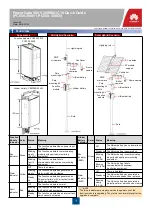
English |
21
Bosch Power Tools
1 609 92A 37T | (14.9.16)
Connecting the Air Supply
Ensure that the air pressure is not lower than 6.3 bar
(91 psi) because the pneumatic tool is designed for
this operating pressure.
For maximum performance, the values for the inner hose di-
ameter as well as the connection threads must be adhered to
as listed in the “Technical Data” Table. To maintain the full
performance, only use hoses with a maximum length of 4 m.
The compressed air supplied should be free of foreign materi-
al and moisture to protect the tool from damage, contamina-
tion, and the formation of rust.
Note:
The use of a compressed-air maintenance unit is neces-
sary. This ensures proper function of the pneumatic tools.
Observe the operating instructions of the maintenance unit.
All fittings, connecting lines and hoses must be dimensioned
for the pressure and the required air volume.
Avoid restrictions in the air supply, e.g., from pinching, kink-
ing, or stretching!
When in doubt, check the pressure at the air inlet with a pres-
sure gauge with the pneumatic tool switched on.
Connecting the Air Supply to the Pneumatic Tool
(see figure C)
– Screw hose fitting
6
into the connection socket at air inlet
7
.
To avoid damage to interior valve components of the pneu-
matic tool when screwing hose fitting
6
in or out, it is rec-
ommended to counter-hold the projecting connection
socket of air intake
7
with an open-end wrench (size
22 mm).
– Loosen hose clamp
16
of supply-air hose
18
, mount the
supply-air hose to hose fitting
6
and retighten the hose
clamp.
Note:
Always mount the supply-air hose to the pneumatic tool
first, then to the maintenance unit.
Changing Application Tools on the Screw Head
with External Square Drive (see figure D)
(0 607 661 505/... 507/... 509)
When working with an application tool, pay attention
that the application tool is firmly seated on the tool
holder.
When the application tool is not firmly connected
with the tool holder, it can come loose again and not be
controlled.
Inserting
– Press in the pin on the drive square of the tool holder
2
,
e. g. using a small screwdriver, and slide the tool bit
1
over
the drive square. Pay attention that the pin engages in the
recess of the tool bit.
Removing
– Press in the pin in the recess of the tool bit
1
and pull the
tool bit out of the tool holder
2
.
Changing Application Tools on the Head with
Quick-change Chuck (see figure E)
(0 607 661 506/... 510)
When inserting an application tool, pay attention that
the shank of the application tool is firmly seated in the
tool holder.
When the shank of the application tool is not
inserted deep enough in the tool holder, the application
tool can become loose again and not be controlled.
Inserting
Use only application tools with an appropriate shank end (see
“Technical Data”).
– Pull the sleeve
13
of the quick-change chuck to the front
and hold.
– Place the application tool
1
into the tool holder
2
and re-
lease the sleeve
13
.
Removing
– Pull the sleeve
13
of the quick-change chuck to the front
and hold.
– Take the application tool
1
from the tool holder
2
and re-
lease the sleeve
13
.
Operation
Starting Operation
The pneumatic tool works optimally at a working pressure of
6.3 bar (91 psi), measured at the air inlet when the pneumat-
ic tool is switched on.
Reversing the rotational direction (see figure F)
Pay attention to the direction of rotation that is set, be-
fore switching on the pneumatic tool.
For example,
when a screw is to be loosened and the direction of rota-
tion is set so that the screw is tightened, this can lead to a
strong uncontrolled movement of the pneumatic tool.
Operate the switch 10 for directional rotation only
when the pneumatic tool is not in use.
–
Right rotation:
Slide the switch
10
for directional rotation
to the right.
–
Left rotation:
Slide the switch
10
for directional rotation
to the left.
Starting and Stopping
General Information
Note:
When the pneumatic tool does not start, for example af-
ter a longer rest period, disconnect the air supply, and turn
the motor by the tool holder
2
several times through. This re-
moves the adhesive forces.
To save energy, only switch the pneumatic tool on when you
are using it.
Switching On and Off
The pneumatic tools have a torque, dependent on an
impulse
mechanism with shut-down
, which is adjustable over a wide
range. It activates when the set torque is reached.
– To
start
the machine press the on/off switch
4
to the stop.
OBJ_BUCH-1993-004.book Page 21 Wednesday, September 14, 2016 9:08 AM
















































